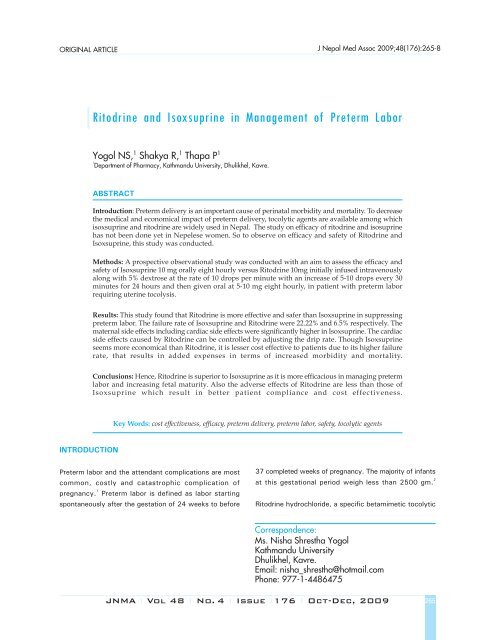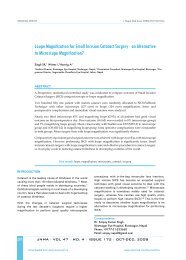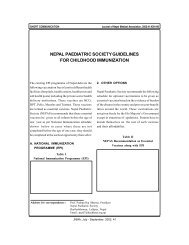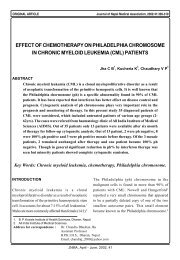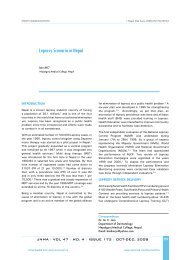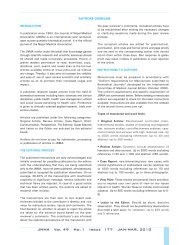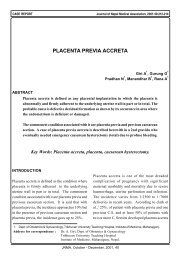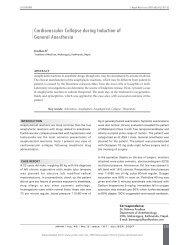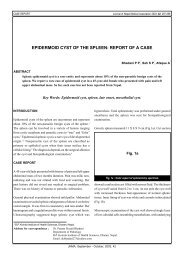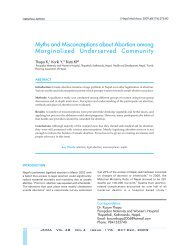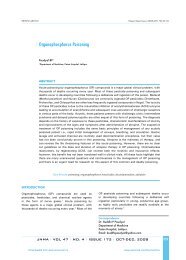Ritodrine and Isoxsuprine in Management of Preterm Labor
Ritodrine and Isoxsuprine in Management of Preterm Labor
Ritodrine and Isoxsuprine in Management of Preterm Labor
You also want an ePaper? Increase the reach of your titles
YUMPU automatically turns print PDFs into web optimized ePapers that Google loves.
ORIGINAL ARTICLE J Nepal Med Assoc 2009;48(176):265-8<br />
<strong>Ritodr<strong>in</strong>e</strong> <strong>and</strong> <strong>Isoxsupr<strong>in</strong>e</strong> <strong>in</strong> <strong>Management</strong> <strong>of</strong> <strong>Preterm</strong> <strong>Labor</strong><br />
Yogol NS, 1 Shakya R, 1 Thapa P 1<br />
1<br />
Department <strong>of</strong> Pharmacy, Kathm<strong>and</strong>u University, Dhulikhel, Kavre.<br />
ABSTRACT<br />
Introduction: <strong>Preterm</strong> delivery is an important cause <strong>of</strong> per<strong>in</strong>atal morbidity <strong>and</strong> mortality. To decrease<br />
the medical <strong>and</strong> economical impact <strong>of</strong> preterm delivery, tocolytic agents are available among which<br />
isoxsupr<strong>in</strong>e <strong>and</strong> ritodr<strong>in</strong>e are widely used <strong>in</strong> Nepal. The study on efficacy <strong>of</strong> ritodr<strong>in</strong>e <strong>and</strong> isosupr<strong>in</strong>e<br />
has not been done yet <strong>in</strong> Nepelese women. So to observe on efficacy <strong>and</strong> safety <strong>of</strong> <strong>Ritodr<strong>in</strong>e</strong> <strong>and</strong><br />
<strong>Isoxsupr<strong>in</strong>e</strong>, this study was conducted.<br />
Methods: A prospective observational study was conducted with an aim to assess the efficacy <strong>and</strong><br />
safety <strong>of</strong> <strong>Isoxsupr<strong>in</strong>e</strong> 10 mg orally eight hourly versus <strong>Ritodr<strong>in</strong>e</strong> 10mg <strong>in</strong>itially <strong>in</strong>fused <strong>in</strong>travenously<br />
along with 5% dextrose at the rate <strong>of</strong> 10 drops per m<strong>in</strong>ute with an <strong>in</strong>crease <strong>of</strong> 5-10 drops every 30<br />
m<strong>in</strong>utes for 24 hours <strong>and</strong> then given oral at 5-10 mg eight hourly, <strong>in</strong> patient with preterm labor<br />
requir<strong>in</strong>g uter<strong>in</strong>e tocolysis.<br />
Results: This study found that <strong>Ritodr<strong>in</strong>e</strong> is more effective <strong>and</strong> safer than <strong>Isoxsupr<strong>in</strong>e</strong> <strong>in</strong> suppress<strong>in</strong>g<br />
preterm labor. The failure rate <strong>of</strong> <strong>Isoxsupr<strong>in</strong>e</strong> <strong>and</strong> <strong>Ritodr<strong>in</strong>e</strong> were 22.22% <strong>and</strong> 6.5% respectively. The<br />
maternal side effects <strong>in</strong>clud<strong>in</strong>g cardiac side effects were significantly higher <strong>in</strong> <strong>Isoxsupr<strong>in</strong>e</strong>. The cardiac<br />
side effects caused by <strong>Ritodr<strong>in</strong>e</strong> can be controlled by adjust<strong>in</strong>g the drip rate. Though <strong>Isoxsupr<strong>in</strong>e</strong><br />
seems more economical than <strong>Ritodr<strong>in</strong>e</strong>, it is lesser cost effective to patients due to its higher failure<br />
rate, that results <strong>in</strong> added expenses <strong>in</strong> terms <strong>of</strong> <strong>in</strong>creased morbidity <strong>and</strong> mortality.<br />
Conclusions: Hence, <strong>Ritodr<strong>in</strong>e</strong> is superior to <strong>Isoxsupr<strong>in</strong>e</strong> as it is more efficacious <strong>in</strong> manag<strong>in</strong>g preterm<br />
labor <strong>and</strong> <strong>in</strong>creas<strong>in</strong>g fetal maturity. Also the adverse effects <strong>of</strong> <strong>Ritodr<strong>in</strong>e</strong> are less than those <strong>of</strong><br />
<strong>Isoxsupr<strong>in</strong>e</strong> which result <strong>in</strong> better patient compliance <strong>and</strong> cost effectiveness.<br />
Key Words: cost effectiveness, efficacy, preterm delivery, preterm labor, safety, tocolytic agents<br />
INTRODUCTION<br />
<strong>Preterm</strong> labor <strong>and</strong> the attendant complications are most<br />
common, costly <strong>and</strong> catastrophic complication <strong>of</strong><br />
pregnancy. 1<br />
<strong>Preterm</strong> labor is def<strong>in</strong>ed as labor start<strong>in</strong>g<br />
spontaneously after the gestation <strong>of</strong> 24 weeks to before<br />
37 completed weeks <strong>of</strong> pregnancy. The majority <strong>of</strong> <strong>in</strong>fants<br />
at this gestational period weigh less than 2500 gm. 2<br />
<strong>Ritodr<strong>in</strong>e</strong> hydrochloride, a specific betamimetic tocolytic<br />
Correspondence:<br />
Ms. Nisha Shrestha Yogol<br />
Kathm<strong>and</strong>u University<br />
Dhulikhel, Kavre.<br />
Email: nisha_shrestha@hotmail.com<br />
Phone: 977-1-4486475<br />
JNMA I Vol 48 I No. 4 I Issue I176 I Oct-Dec, 2009 265
Yogol et al. <strong>Ritodr<strong>in</strong>e</strong> <strong>and</strong> <strong>Isoxsupr<strong>in</strong>e</strong> <strong>in</strong> <strong>Management</strong> <strong>of</strong> <strong>Preterm</strong> <strong>Labor</strong><br />
agent, is associated with fewer maternal side effects. 3,4<br />
<strong>Isoxsupr<strong>in</strong>e</strong> is a slight selective ß 2 –adrenoreceptor tocolytic<br />
agent, whose use has been superseded by more selective<br />
ß 2 -agonists. 5,6 Studies have shown that <strong>Ritodr<strong>in</strong>e</strong> is more<br />
efficacious <strong>in</strong> arrest<strong>in</strong>g preterm labor, delay<strong>in</strong>g delivery<br />
<strong>and</strong> <strong>in</strong>creas<strong>in</strong>g fetal maturity than <strong>Isoxsupr<strong>in</strong>e</strong>. 6-8<br />
<strong>Isoxsupr<strong>in</strong>e</strong> is still used <strong>in</strong> develop<strong>in</strong>g countries due to<br />
its lower price. Though <strong>Ritodr<strong>in</strong>e</strong> is affordable to the<br />
patient it is comparatively expensive. The higher failure<br />
rate <strong>and</strong> the related consequences <strong>of</strong> <strong>Isoxsupr<strong>in</strong>e</strong> make<br />
treatment with <strong>Ritodr<strong>in</strong>e</strong> more cost effective. The failure<br />
<strong>of</strong> preterm labor management results <strong>in</strong> preterm birth or<br />
<strong>in</strong>fant mortality. <strong>Preterm</strong> birth accounts for 70% neonatal<br />
morbidity <strong>and</strong> <strong>in</strong>crease expenses on neonatal care. 9 Many<br />
studies have shown that <strong>Isoxsupr<strong>in</strong>e</strong> has not only caused<br />
<strong>in</strong>creased neonatal morbidity but also shows maternal<br />
<strong>and</strong> fetal side effects. 7-10<br />
METHODS<br />
The prospective observational study was conducted at<br />
Gynecology <strong>and</strong> Obstetric ward <strong>of</strong> Dhulikhel Kathm<strong>and</strong>u<br />
University Teach<strong>in</strong>g Hospital <strong>and</strong> Ante-neonatal Care Unit <strong>of</strong><br />
Maternity Hospital, Thapathali from January 2007 to June<br />
2007. This study was ethically approved by ethical review<br />
committee Kathm<strong>and</strong>u University, School <strong>of</strong> Medical Science.<br />
With <strong>in</strong>formed consent, a total <strong>of</strong> sixty-one pregnant women<br />
were <strong>in</strong>cluded <strong>in</strong> the study. The <strong>in</strong>clusion criteria were:<br />
nulliparous or multiparous ladies <strong>in</strong> between a gestational age<br />
<strong>of</strong> 28-36 weeks, bishops score less than or equal to six <strong>and</strong><br />
with symptoms <strong>and</strong> signs <strong>of</strong> preterm labor. The patients with<br />
cardiovascular disease or asthma or antepartum bleed<strong>in</strong>g were<br />
excluded from the study. Bishops score was assessed to<br />
confirm whether patient is <strong>in</strong> active stage <strong>of</strong> labor or not.<br />
S<strong>in</strong>ce Maternity Hospital at Thapathali <strong>and</strong> Dhulikhel Hospital<br />
have their own protocol for treatment <strong>of</strong> preterm labor, the<br />
patients were assigned accord<strong>in</strong>g to the treatment protocol<br />
<strong>of</strong> concerned hospitals. The subjects at Maternity Hospital,<br />
Thapathali (n=30) were treated with <strong>Isoxsupr<strong>in</strong>e</strong> 10mg every<br />
eight hours. The subjects at Dhulikhel Hospital (n=31) were<br />
treated with <strong>in</strong>travenous <strong>in</strong>fusion <strong>of</strong> <strong>Ritodr<strong>in</strong>e</strong> 10mg with<br />
dextrose 5% at the rate <strong>of</strong> ten drops per m<strong>in</strong>ute (50mcg/m<strong>in</strong>)<br />
<strong>and</strong> the drip rate was <strong>in</strong>creased by 5-10 drops every hour<br />
followed by oral adm<strong>in</strong>istration <strong>of</strong> 5-10mg <strong>Ritodr<strong>in</strong>e</strong> eight<br />
hourly depend<strong>in</strong>g on the severity <strong>of</strong> patient. Maternal pulse,<br />
blood pressure, fetal heart rate <strong>and</strong> uter<strong>in</strong>e contraction were<br />
monitored prior to drug adm<strong>in</strong>istration, then hourly for first<br />
six hours <strong>of</strong> <strong>in</strong>itial dos<strong>in</strong>g <strong>and</strong> then two hourly till the last<br />
dose. In case <strong>of</strong> the subject receiv<strong>in</strong>g <strong>in</strong>travenous <strong>in</strong>fusion <strong>of</strong><br />
<strong>Ritodr<strong>in</strong>e</strong>, the drip rate was adjusted if the pulse rate was<br />
more than 100 per m<strong>in</strong>ute. When there was no control <strong>in</strong><br />
labor pa<strong>in</strong> despite tocolytic therapy, the subjects were subjected<br />
to elective cesarean section.<br />
Basel<strong>in</strong>e evaluation <strong>in</strong>cluded height, weight, maternal age,<br />
socioeconomic status, literacy, gravidity, parity, gestational<br />
period, age at marriage, previous history <strong>of</strong> spontaneous<br />
abortion or preterm delivery, symptoms <strong>of</strong> ur<strong>in</strong>ary tract<br />
<strong>in</strong>fection, history <strong>of</strong> smok<strong>in</strong>g <strong>and</strong> alcohol consumption <strong>and</strong><br />
underly<strong>in</strong>g medical <strong>and</strong> obstetric disorders.<br />
The efficacy was predicted with dim<strong>in</strong>ution <strong>of</strong> abdom<strong>in</strong>al pa<strong>in</strong><br />
<strong>and</strong> backache with absence <strong>of</strong> vag<strong>in</strong>al discharge <strong>and</strong> uter<strong>in</strong>e<br />
contraction. The safety <strong>of</strong> drugs was assessed with abnormal<br />
fetal <strong>and</strong> maternal heart rate <strong>and</strong> maternal side effects. The<br />
total cost <strong>of</strong> management was calculated.<br />
Statistical analysis was done with SPSS version 11.5 data<br />
sheet. Pearson Chi Square test was used to compare efficacy,<br />
prolongation <strong>of</strong> pregnancy <strong>and</strong> adverse effects <strong>of</strong> drugs.<br />
Monitor<strong>in</strong>g parameters pre-<strong>and</strong> post- use <strong>of</strong> drug were compared<br />
by us<strong>in</strong>g paired sample t-test. Mean <strong>and</strong> median were used<br />
as statistical tools to compare cost <strong>of</strong> treatments.<br />
RESULTS<br />
Among 31 patients treated with <strong>Ritodr<strong>in</strong>e</strong>, the preterm<br />
labor management was successful <strong>and</strong> reached term<br />
delivery <strong>in</strong> 29 (93.5%) patients whereas among the<br />
patients treated with <strong>Isoxsupr<strong>in</strong>e</strong>, the treatment was<br />
successful only <strong>in</strong> 22 (73.3%) patients out <strong>of</strong> 30 patients<br />
with P value 0.033 (Figure 1,2). Among them 60% were<br />
primiparous (Table 1).<br />
Table 1. Parity distribution <strong>of</strong> patients at preterm labor<br />
Parity <strong>Isoxsupr<strong>in</strong>e</strong>* <strong>Ritodr<strong>in</strong>e</strong>†<br />
Primiparous 18 (60%) 19 (61.3%)<br />
Multiparous 12 (40%) 12 (38.7%)<br />
*n=30, †n=31<br />
No. <strong>of</strong> patients<br />
30<br />
25<br />
20<br />
15<br />
10<br />
5<br />
0<br />
8<br />
22<br />
<strong>Isoxsupr<strong>in</strong>e</strong><br />
2<br />
29<br />
<strong>Ritodr<strong>in</strong>e</strong><br />
Figure 1. Effectiveness <strong>of</strong> tocolytic agents<br />
Failure<br />
Success<br />
266<br />
JNMA I Vol 48 I No. 4 I Issue I176 I Oct-Dec, 2009
Yogol et al. <strong>Ritodr<strong>in</strong>e</strong> <strong>and</strong> <strong>Isoxsupr<strong>in</strong>e</strong> <strong>in</strong> <strong>Management</strong> <strong>of</strong> <strong>Preterm</strong> <strong>Labor</strong><br />
The study showed that more number <strong>of</strong> patients<br />
experienced adverse effects with <strong>Isoxsupr<strong>in</strong>e</strong> than with<br />
<strong>Ritodr<strong>in</strong>e</strong>. Incidences <strong>of</strong> nausea, vomit<strong>in</strong>g <strong>and</strong> weakness<br />
with <strong>Isoxsupr<strong>in</strong>e</strong> were found to be significantly higher<br />
than with <strong>Ritodr<strong>in</strong>e</strong> (Table 2). Similarly the <strong>in</strong>cidence <strong>of</strong><br />
cardiac side effects such as tachycardia <strong>and</strong>/or hypotension<br />
was also significantly higher <strong>in</strong> <strong>Isoxsupr<strong>in</strong>e</strong> group with<br />
P value 0.033 (Table 3). Eight (26.7%) out <strong>of</strong> 30 treated<br />
patients with <strong>Isoxsupr<strong>in</strong>e</strong> experienced cardiac side effects<br />
(hypotension <strong>and</strong>/ or tachycardia) whereas only two<br />
(6.5%) out <strong>of</strong> 31 patients treated with <strong>Ritodr<strong>in</strong>e</strong><br />
experienced same cardiac side effects.<br />
Table 2. Maternal adverse effects<br />
Adverse Effect <strong>Isoxsupr<strong>in</strong>e</strong>* <strong>Ritodr<strong>in</strong>e</strong>† P-value<br />
Nausea 12 (40%) 1 (3.2%) 0.0004<br />
Vomit<strong>in</strong>g 6 (20%) 1 (3.2%) 0.039<br />
Weakness 5 (16.7%) - 0.017<br />
Dry mouth 1 (3.3%) - 0.305<br />
Headache 2 (6.7%) 2 (6.5%) 0.972<br />
Nervousness 2 (6.7%) - 0.143<br />
*n=30, †n=31<br />
Table 3. Cardiac side effects<br />
Cardiac side effects <strong>Isoxsupr<strong>in</strong>e</strong>* <strong>Ritodr<strong>in</strong>e</strong>† P-value<br />
Present 8 (26.67%) 2 (6.45%) 0.033<br />
Absent 22 (73.33%) 29 (93.55%)<br />
*n=30, †n=31<br />
The study showed no significant changes <strong>in</strong> pre-drug<br />
<strong>and</strong> post-drug monitor<strong>in</strong>g parameters (maternal blood<br />
pressure, pulse <strong>and</strong> fetal heart rate) with either <strong>Isoxsupr<strong>in</strong>e</strong><br />
or <strong>Ritodr<strong>in</strong>e</strong>. However, uter<strong>in</strong>e contraction was significantly<br />
reduced after adm<strong>in</strong>istration <strong>of</strong> drugs <strong>in</strong> both groups<br />
(Table 4).<br />
In this study, the duration <strong>of</strong> treatment with <strong>Isoxsupr<strong>in</strong>e</strong><br />
ranged from three to 21 days (median seven days) <strong>and</strong><br />
that with <strong>Ritodr<strong>in</strong>e</strong> ranged from two to 12 days (median<br />
six days). The average cost <strong>of</strong> treatment per patient with<br />
<strong>Isoxsupr<strong>in</strong>e</strong> was $0.62(1$ = N.Rs.74) <strong>and</strong> that with<br />
<strong>Ritodr<strong>in</strong>e</strong> was $5.0(<strong>in</strong>clud<strong>in</strong>g cost <strong>of</strong> <strong>in</strong>travenous set,<br />
<strong>in</strong>travenous canula <strong>and</strong> <strong>in</strong>jection 5% Dextrose). The cost<br />
<strong>in</strong>volved <strong>in</strong> <strong>Isoxsupr<strong>in</strong>e</strong> treatment as compared to <strong>Ritodr<strong>in</strong>e</strong><br />
treatment was found to be <strong>in</strong> the ratio <strong>of</strong> 1:8.<br />
DISCUSSION<br />
The success rate <strong>of</strong> preterm labor management was<br />
significantly greater for <strong>Ritodr<strong>in</strong>e</strong> compared to <strong>Isoxsupr<strong>in</strong>e</strong><br />
(P= 0.033). A similar study carried by Roy et al showed<br />
significant difference <strong>in</strong> effectiveness between two<br />
groups. Their study found that tocolysis was successful<br />
<strong>in</strong> 24 (96%) <strong>and</strong> 21 (84%) patients with <strong>Ritodr<strong>in</strong>e</strong> <strong>and</strong><br />
<strong>Isoxsupr<strong>in</strong>e</strong> therapy respectively. 7 The study carried out<br />
by Ikeda et al also showed that the efficacy <strong>of</strong> <strong>Ritodr<strong>in</strong>e</strong><br />
was greater than that <strong>of</strong> <strong>Isoxsupr<strong>in</strong>e</strong>. 8 Study carried out<br />
by Sirohiwal et al found that tocolysis with <strong>Ritodr<strong>in</strong>e</strong><br />
was successful <strong>in</strong> 76.7% patients <strong>and</strong> with <strong>Isoxsupr<strong>in</strong>e</strong><br />
it was successful <strong>in</strong> 63.3% patients. 6<br />
The results are<br />
consistent with the f<strong>in</strong>d<strong>in</strong>gs <strong>of</strong> this study.<br />
In the present study, when duration <strong>of</strong> prolongation <strong>of</strong><br />
pregnancy was compared, <strong>Ritodr<strong>in</strong>e</strong> was found to be<br />
more effective. The study conducted by Sirohiwal et al<br />
found that there were 43% <strong>and</strong> 33% <strong>of</strong> term deliveries<br />
<strong>in</strong>-patient assigned for <strong>Ritodr<strong>in</strong>e</strong> <strong>and</strong> <strong>Isoxsupr<strong>in</strong>e</strong><br />
respectively. 6 Another study has also found more number<br />
<strong>of</strong> patients allocated to <strong>Ritodr<strong>in</strong>e</strong> group reached term<br />
pregnancy. 7<br />
The present study found a higher <strong>in</strong>cidence <strong>of</strong> occurrence<br />
<strong>of</strong> adverse effects with <strong>Isoxsupr<strong>in</strong>e</strong> than with <strong>Ritodr<strong>in</strong>e</strong>,<br />
so <strong>Ritodr<strong>in</strong>e</strong> can be considered as relatively safer to the<br />
patient. The study carried out by Roy et al also found<br />
that patients <strong>in</strong> <strong>Ritodr<strong>in</strong>e</strong> group experienced fewer side<br />
effects compared to <strong>Isoxsupr<strong>in</strong>e</strong> treated patients. 7 The<br />
study carried out by Ikeda et al showed that adverse<br />
effects like hypotension <strong>and</strong> tachycardia were lesser with<br />
<strong>Ritodr<strong>in</strong>e</strong> than with <strong>Isoxsupr<strong>in</strong>e</strong>. 8 The study conducted<br />
by Barden et al showed that <strong>Ritodr<strong>in</strong>e</strong> seems to be<br />
relatively safer <strong>and</strong> side effects are usually tolerable<br />
JNMA I Vol 48 I No. 4 I Issue I176 I Oct-Dec, 2009 267
Yogol et al. <strong>Ritodr<strong>in</strong>e</strong> <strong>and</strong> <strong>Isoxsupr<strong>in</strong>e</strong> <strong>in</strong> <strong>Management</strong> <strong>of</strong> <strong>Preterm</strong> <strong>Labor</strong><br />
compared to <strong>Isoxsupr<strong>in</strong>e</strong>. 11<br />
There are no significant changes <strong>in</strong> pre- drug <strong>and</strong> post<br />
drug monitor<strong>in</strong>g parameters with either <strong>Isoxsupr<strong>in</strong>e</strong> or<br />
<strong>Ritodr<strong>in</strong>e</strong>. However, uter<strong>in</strong>e contraction was significantly<br />
reduced after adm<strong>in</strong>istration <strong>of</strong> drugs <strong>in</strong> both <strong>Ritodr<strong>in</strong>e</strong><br />
<strong>and</strong> <strong>Isoxsupr<strong>in</strong>e</strong> group which <strong>in</strong>dicates uter<strong>in</strong>e relaxant<br />
effect <strong>of</strong> both drugs. Despite this, the rate <strong>of</strong> dim<strong>in</strong>ution<br />
<strong>of</strong> number <strong>of</strong> uter<strong>in</strong>e contractions was found to be higher<br />
with <strong>Ritodr<strong>in</strong>e</strong> than with <strong>Isoxsupr<strong>in</strong>e</strong> which <strong>in</strong>dicates that<br />
<strong>Ritodr<strong>in</strong>e</strong> has more rapid onset <strong>of</strong> action than <strong>Isoxsupr<strong>in</strong>e</strong>.<br />
This difference <strong>in</strong> onset <strong>of</strong> action could be due to the<br />
difference <strong>in</strong> route <strong>of</strong> adm<strong>in</strong>istration as <strong>Ritodr<strong>in</strong>e</strong> was<br />
<strong>in</strong>itially adm<strong>in</strong>istered <strong>in</strong>travenous while <strong>Isoxsupr<strong>in</strong>e</strong> was<br />
given orally. However, the results <strong>of</strong> this study suggest<br />
that <strong>Ritodr<strong>in</strong>e</strong> more effectively suppresses uter<strong>in</strong>e motility<br />
<strong>and</strong> also has lesser effects on maternal cardiovascular<br />
system.<br />
The direct cost <strong>of</strong> treatment with <strong>Ritodr<strong>in</strong>e</strong> is higher than<br />
that with <strong>Isoxsupr<strong>in</strong>e</strong>; but it is still affordable to the<br />
patient. The study carried out by Roy et al showed the<br />
cost <strong>in</strong>volved <strong>in</strong> <strong>Isoxsupr<strong>in</strong>e</strong> treatment as compared to<br />
<strong>Ritodr<strong>in</strong>e</strong> treatment is <strong>in</strong> the ratio <strong>of</strong> 1:3. 7<br />
In that study,<br />
<strong>Isoxsupr<strong>in</strong>e</strong> was used <strong>in</strong> <strong>in</strong>jectable form as start<strong>in</strong>g dose<br />
followed by oral tablets after two to three days. In present<br />
study only oral tablets <strong>of</strong> <strong>Isoxsupr<strong>in</strong>e</strong> was used, which<br />
could have resulted <strong>in</strong> the difference <strong>in</strong> cost <strong>of</strong> treatment<br />
between the two studies.<br />
The study showed <strong>Ritodr<strong>in</strong>e</strong> has higher success rate than<br />
<strong>Isoxsupr<strong>in</strong>e</strong> <strong>in</strong> prevent<strong>in</strong>g preterm deliveries (93.5% vs<br />
73.0%). It is well accepted that the consequences <strong>of</strong><br />
failure <strong>of</strong> tocolysis are neonatal morbidity <strong>and</strong> mortality,<br />
which cost more than the direct cost <strong>of</strong> treatment <strong>of</strong><br />
preterm labor either with <strong>Ritodr<strong>in</strong>e</strong> or with <strong>Isoxsupr<strong>in</strong>e</strong>.<br />
Aga<strong>in</strong> the <strong>in</strong>cidences <strong>of</strong> overall adverse effects <strong>in</strong>clud<strong>in</strong>g<br />
maternal cardiac side effects such as tachycardia <strong>and</strong><br />
hypotension were also significantly higher <strong>in</strong> <strong>Isoxsupr<strong>in</strong>e</strong><br />
(26.7%) than <strong>in</strong> <strong>Ritodr<strong>in</strong>e</strong> (6.5%). Several studies have<br />
shown that <strong>Isoxsupr<strong>in</strong>e</strong> has limited therapeutic value<br />
with unpleasant side effects <strong>and</strong> efficacy. 7,8,10,12<br />
Hence,<br />
<strong>Ritodr<strong>in</strong>e</strong> seems to be a much safer tocolytic agent than<br />
<strong>Isoxsupr<strong>in</strong>e</strong>. Although the direct cost <strong>of</strong> treatment with<br />
<strong>Ritodr<strong>in</strong>e</strong> is higher than that with <strong>Isoxsupr<strong>in</strong>e</strong>, it is still<br />
bearable to the patient. Hence, it could be the more<br />
preferable betamimetic agent used as tocolytic agent<br />
rather than <strong>Isoxsupr<strong>in</strong>e</strong>.<br />
S<strong>in</strong>ce the sample size <strong>of</strong> this study was small <strong>and</strong> the<br />
study was conducted <strong>in</strong> only two hospitals <strong>of</strong> Nepal for<br />
short duration, the study cannot be del<strong>in</strong>eated to whole<br />
population. R<strong>and</strong>omized control trials would have produced<br />
more reliable results.<br />
CONCLUSIONS<br />
The study found that <strong>Ritodr<strong>in</strong>e</strong> was significantly successful<br />
<strong>in</strong> arrest<strong>in</strong>g preterm labor than <strong>Isoxsupr<strong>in</strong>e</strong>. The study<br />
also found that <strong>Ritodr<strong>in</strong>e</strong> was comparatively safer than<br />
<strong>Isoxsupr<strong>in</strong>e</strong> <strong>in</strong> terms <strong>of</strong> occurrence <strong>of</strong> cardiac side effects<br />
as well as extra cardiac maternal side effects. Although<br />
cost <strong>of</strong> <strong>Ritodr<strong>in</strong>e</strong> was higher than cost <strong>of</strong> <strong>Isoxsupr<strong>in</strong>e</strong>,<br />
it was justifiable <strong>in</strong> long term <strong>in</strong> view <strong>of</strong> <strong>in</strong>creased<br />
economic burden <strong>of</strong> tocolytic failure <strong>and</strong> <strong>in</strong>creased adverse<br />
effects.<br />
ACKNOWLEDGEMENTS<br />
Staff <strong>of</strong> Obstetrics <strong>and</strong> Gynecology Department <strong>of</strong><br />
Dhulikhel Hospital, Maternity Hospital Thapathali <strong>and</strong><br />
staffs <strong>of</strong> Pharmacy Department, Kathm<strong>and</strong>u University.<br />
REFERENCES<br />
1. Morrison JC. <strong>Preterm</strong> <strong>Labor</strong>: Prediction <strong>and</strong> Treatment.<br />
Obstetrics <strong>and</strong> Gynecology Cl<strong>in</strong>ics <strong>of</strong> North America.<br />
2005;32(3):369-81.<br />
2. Gabby SG, Niebyl JP, Simpson JL. <strong>Preterm</strong> birth. Obstetrics,<br />
Normal & Problem Pregnancies, 4th ed. Philadelphia: Churchill<br />
Liv<strong>in</strong>gstone; 2002. p. 787-91.<br />
3. Goldenberg RL & Rouse DJ. Prevention <strong>of</strong> preterm birth. N<br />
Engl J Med 1998;339:313-20.<br />
4. Papatsonis DNM, Van Geijn HP, Ader HJ, Lange FM, Bleker<br />
OP, Dekker GA. Nifedip<strong>in</strong>e <strong>and</strong> <strong>Ritodr<strong>in</strong>e</strong> <strong>in</strong> the management<br />
<strong>of</strong> preterm labor: a r<strong>and</strong>omized multicenter trial. Obstet<br />
Gynecol. 1997;90:230-4.<br />
5. Gennaro AR, Chase GD, Marderosian AD, Hanson GR, Hussar<br />
DA. Rem<strong>in</strong>gton: The Science & Practice <strong>of</strong> Pharmacy. 19th ed.<br />
USA: Mack Publish<strong>in</strong>g Company; 1993. p. 992,998.<br />
6. Sirohiwal D, Sachan A, Bano A, Gulati N. Evaluation <strong>of</strong> ritodr<strong>in</strong>e<br />
for tocolysis <strong>in</strong> preterm labor. J Obs Gyn. 2001;51:66-7.<br />
7. Roy V, Prasad GS, Latha K. Tocolysis with <strong>Ritodr<strong>in</strong>e</strong>: A<br />
Comparative Study <strong>in</strong> <strong>Preterm</strong> <strong>Labor</strong>. Pakistan J Medical Sciences. 2006;22:1.<br />
8. Ikeda S, Tamaoki H, Akahane M, Nebashi Y. Effect <strong>of</strong> ritodr<strong>in</strong>e<br />
hydrochloride, a beta 2- adrenoreceptor stimulant, on uter<strong>in</strong>e<br />
motilities <strong>in</strong> late pregnancy. Jpn J Pharmacol. 1984; 35(3):319-<br />
26.<br />
9. Newton ER. <strong>Preterm</strong> labor, preterm premature rupture <strong>of</strong><br />
membranes <strong>and</strong> chorioamnionitis. Cl<strong>in</strong> Per<strong>in</strong>atol. 2005 Sep;<br />
32(3):571-600.<br />
10. Kazzi NJ Gross TL Kazzi GM Williams TG. Neonatal<br />
complication follow<strong>in</strong>g <strong>in</strong> utero exposure to <strong>in</strong>travenous<br />
ritodr<strong>in</strong>e. Acta Obstet Gynecol Sc<strong>and</strong>. 1987;66(1):65-9.<br />
11. Merkatz IR, Peter JB, Barden TP. <strong>Ritodr<strong>in</strong>e</strong> hydrochloride: a<br />
betamimetic agent for use <strong>in</strong> preterm labor. II. Evidence <strong>of</strong><br />
efficacy. Obstet Gynecol. 1980;56(1):7-12.<br />
12. K<strong>in</strong>g JF, Grant A, Keirse MJ, Chalmers I. Betamimetics <strong>in</strong><br />
preterm labor. An overview <strong>of</strong> r<strong>and</strong>omized controlled trials.<br />
Br J Obstet Gynaecol. 1998;95:211-22.<br />
268<br />
JNMA I Vol 48 I No. 4 I Issue I176 I Oct-Dec, 2009


